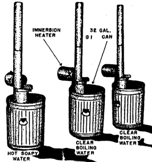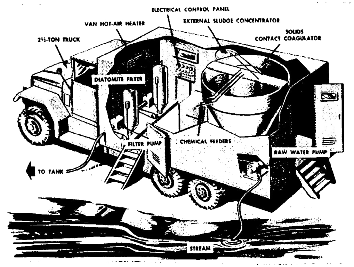|
CORRESPONDENCE
COURSE
U.S. ARMY ACADEMY OF HEALTH SCIENCES
SUBCOURSE MD0008 EDITION 100
INTRODUCTION TO MILITARY PREVENTIVE MEDICINE
The motto of the Army Medical Department "to conserve the fighting
strength" aptly summarizes in one phrase the mission of all components
of AMEDD and the major objective of military preventive medicine.
Military history is replete with examples which emphasize the
importance of preventing disease and noncombat injury as the principal
means of conserving the fighting strength.
Today, military preventive medicine remains a most powerful weapon
against disease and trauma. Environmental hazards have posed a threat
to man since the beginning of his existence. Communicable disease has
not been conquered; it is only being contained or held at bay. Thus,
it behooves everyone to equip himself with a working knowledge of
health and environment principles, methods, and practices. Such
knowledge will help you, as a member of the Army Medical Department,
to survive, to perform your assignment, and to help others.
This subcourse is designed to give you a general introduction to
military preventive medicine with particular emphasis on water supply
and waste disposal, climate injury and disease control.
----------------------
Length: 178 Pages
Estimated Hours to Complete: 14
Format: PDF file
Size: 6.8 MB
----------------------------
Anyone may take this course. However, to receive credit hours, you
must be officially enrolled and complete an examination furnished by
the Nonresident Instruction Branch at Fort Sam Houston, Texas.
Enrollment is normally limited to Department of Defense personnel.
Others may apply for enrollment, but acceptance is not guaranteed.

Introduction to Military Preventive
Medicine
Distance Learning
Course
178 Pages
Est. 14 Hours
6.8 MB pdf file
Download Now |
|

TABLE OF CONTENTS
INTRODUCTION
1 IMPORTANCE AND SCOPE OF MILITARY PREVENTIVE MEDICINE
Exercises
2 THE ARMY IMMUNIZATION PROGRAM
Exercises
3 FIELD FORCES/FIXED INSTALLATION
Section I. Medical Threat to Field Forces
Section II. Preventive Medicine Activities in Fixed Installations
Exercises
4 CLIMATIC INJURY CONTROL
Section I. Environmental Cold Injuries
Section II. Environmental Heat Injuries
Exercises
5 MEDICAL ASPECTS OF WATER SUPPLY
Section I. Introduction
Section II. Principles of Water Purification
Section III. Quartermaster Water Treatment
Exercises
6 FIELD WATER SUPPLY AND WASTE DISPOSAL
Section I. Individual and Unit Water Supply and Purification
Section II. Field Waste Disposal
Section III. Field Sanitary Devices
Exercises
7 MILITARY MEDICAL ENTOMOLOGY FIELD CONTROL
Exercises
8 SEXUALLY TRANSMITTED DISEASES
Section I. The Army's Sexually Transmitted Disease Control
Program
Section II. The Epidemiology of Sexually Transmitted Diseases
Section III. Other Sexually Transmitted Diseases
Exercises
------------------------------------------------
LESSON 1
IMPORTANCE AND SCOPE OF MILITARY PREVENTIVE MEDICINE
1-1. BACKGROUND
a. Since earliest recorded history, military leaders
have been aware of the devastating effects of diseases upon troops.
Around 400 BC, Susruta, an Indian physician, wrote: "All common
practice of the enemy under such circumstances is to poison the wells
on the roadside, the articles of food, the shade of trees (shadowy
places), and the field and forage for cattle. Hence, it is incumbent
on a physician marching with troops to inspect, examine, and purify
these before using any of them in case they be poisoned." Later,
around AD 400, Vegetius, a Roman leader, wrote: "large bodies of
troops should not camp too long in any one place, since epidemic
disease can arise from corruption of the air and water and can only be
prevented by frequent change of camp. Troops should not camp upon dry
hillsides devoid of shade and in summer should always be provide with
tents. One drink of polluted water may be as potent as poison in
starting an epidemic. In periods of great heat, all marching should be
done before sunrise. In winter, little can be expected of the soldier
if he is allowed to freeze. It is the duty of the commanding officer
to provide good water, proper food, and medical attention for the
sick." The responsibility of the commander to provide these essentials
is still recognized and emphasized today.
b. Some of the greatest fiascos in military history
have been the result of a breakdown in hygiene and disease control.
For example, when Napoleon Bonaparte sent a force of 22,000 men to
suppress a rebellion in the French colony of Haiti in 1803, 20,000 men
died from yellow fever. Subsequently, Haiti achieved independence with
little French opposition. Again in 1813, Napoleon invaded Russia with
an Army of 480,000. Although he succeeded in taking Moscow, his troops
were decimated by guerrillas disease, and cold injury, forcing his
retreat. Only 10,000 men returned to France. Of the 470,000 men who
were lost, only 60,000 were killed in action; the remainder died of
disease and cold injury.
c. The American experience has not been greatly different. During
the Civil War, twice as many men in both the Union and Confederate
armies died from disease as from enemy-inflicted wounds. During the
Cuban campaign of the Spanish-American War, the ravages of yellow
fever and other diseases accounted for five deaths for every combat
death. During World War I, for the first time in history, the ratio of
deaths from disease to deaths from combat causes was reduced to 1:1.
Although disease is not longer the major cause of death in combat, it
is still responsible for an overwhelming majority of the hospital
admissions and continues to be a major problem.
1-2. EFFECTS OF DISEASES UPON TROOPS
a. When one speaks of Military Preventive Medicine, it
is traditional to give examples of battles, wars, and nations that
have been lost because of epidemics. One of the best examples is that
of Napoleon's Grand Army which marched into Russia with 480,000 men
and retreated back to Paris with only 10,000. Of the 470,000 that did
not make it back only 60,000 fell from combat causes. The remaining
410,000 succumbed to disease. Cold injury, caused by the severe
Russian winter, accounted for many and a disease called epidemic
(louse-borne) typhus accounted for even more. Prior to World War I,
the leading cause of death among military troops during wartime was
disease.
b. History shows that disease and injury as military problems are
factors for which the military leader must plan. In Table 1, the
periods of war listed were ones in which combat was the heaviest. In
spite of these concentrated fighting periods, hospital admissions for
disease and nonbattle injury far exceeded admissions because of
hostile action of the enemy. Furthermore, experience reveals that
hospital admissions for disease usually exceed hospital admissions for
nonbattle injury and battle injury combined. For example, of the 81.8
percent hospital admissions for disease and noncombat injury in
Vietnam in 1969, only 13.7 percent were for nonbattle injury and 68.1
percent were for disease.
From
Introduction to Military Preventive Medicine
|


